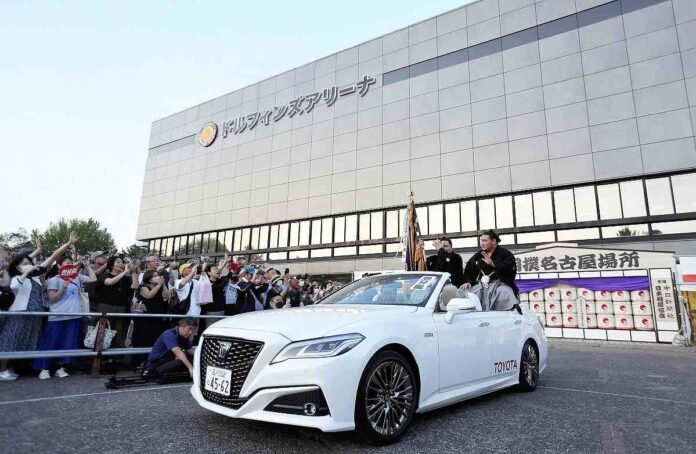Hoshoryu, right, begins his victory parade outside the Aichi Prefectural Gym after winning the Nagoya Grand Sumo Tournament last July.
11:01 JST, July 10, 2024
That time of year has arrived, when Nagoya hosts its only major sumo tournament. And this year’s event, which begins on July 14, has an even more special significance.
The curtain will fall for the last time on the Aichi Prefectural Gym (now known as Dolphins Arena), which has hosted the Nagoya tournament since 1965. It marks the end of an era, and from next year the tournament will be held at the new IG Arena that is being built nearby.
The Nagoya tournament was elevated to membership in the Grand Sumo series in 1958. At the time, it was held in the Kanayama Gym, which had no air conditioning and was nicknamed the “South Seas Tournament.” Blocks of ice were stacked to cool things down a bit.
Nagoya is unbearably humid in July. In most years, the rainy season is not over during the first half of the tournament, which occasionally brings a heavy evening shower and further increases the humidity. It is undeniably difficult to stay in top condition.
While the scientific evidence on the extent to which climate affects performance is unclear, the tournament has historically seen an inordinate number of champions come from the maegashira ranks. In the 65 years that Nagoya has hosted the tournament — it was moved to Tokyo in 2020 due to the pandemic — six maegashira-ranked wrestlers have won the Emperor’s Cup, the most among the six annual tournaments.
We often hear references to the “stormy Spring Tournament” because of its history full of unexpected twists, but in reality “stormy” might be more applicable to the Nagoya Tournament.
Many of the championships won by maegashira wrestlers in Nagoya are historic, with Hawaiian Takamiyama’s first victory in 1972 perhaps being the most prominent.
In the long history of sumo it was a turning point, as it was the first time a foreign-born wrestler had won.
Also in Nagoya it was wrestlers like Kongo, Kotofuji, Mitoizumi and Ichinojo, who were not on everyone’s list of favorites for the tournament, who emerged from the ranks of the maegashira and amazed sumo fans by taking home the title.
Conversely, there have been wrestlers who have used their success in Nagoya as a springboard to promotion to yokozuna or ozeki, surpassing more famous wrestlers in the blink of an eye. Legends such as Kitanoumi and Chiyonofuji received the ceremonial messenger from the Japan Sumo Association informing them of their promotion to yokozuna while in Nagoya.
This is the year that the old gym will hold its last tournament. What drama awaits? I can’t wait for the first day.
— Kamimura is a sumo expert.



